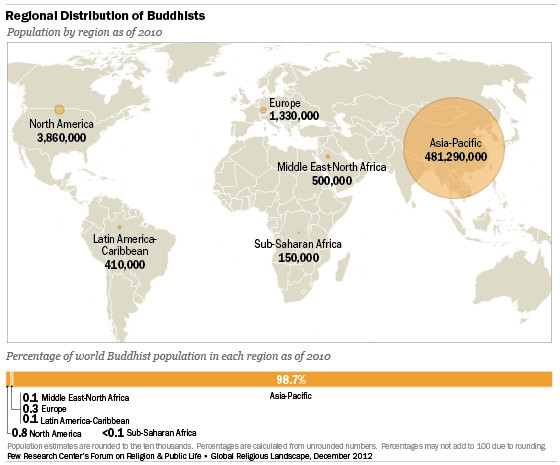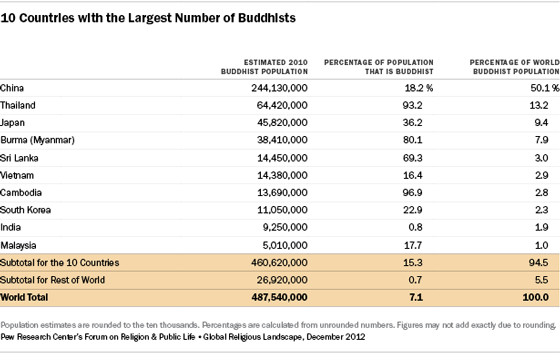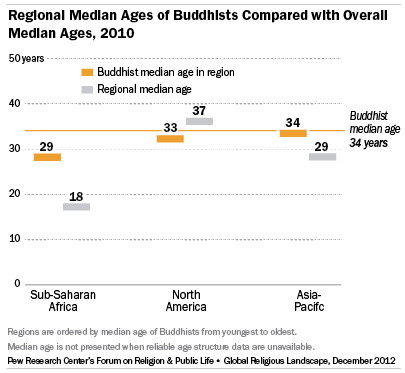Buddhism, a spiritual tradition that originated in ancient India, has spread across the globe over millennia. Today, understanding where Buddhism is practiced offers insights into its diverse forms and global reach. This article delves into the geographical distribution of Buddhism, highlighting key regions and countries where this faith thrives.
While approximately 488 million people, or 7% of the world’s population, identified as Buddhist in 2010, the vast majority (nearly 99%) reside in the Asia-Pacific region. This region remains the heartland of Buddhism, but significant Buddhist communities also exist in North America and Europe, each with over a million adherents.
 grl-buddhist-1
grl-buddhist-1
Image: Global Distribution of Buddhism – Illustrating the concentration of Buddhist populations worldwide.
Within the Asia-Pacific, however, Buddhists constitute only about 12% of the total population. In North America, around 1% are Buddhist, and in other regions, the proportion is less than 1%. This distribution underscores that while Buddhism’s global footprint is expanding, its primary presence remains heavily concentrated in Asia.
All ten countries with the largest Buddhist populations are situated in the Asia-Pacific region, collectively accounting for 95% of the world’s Buddhists. China stands out, harboring half (50%) of the global Buddhist population. Other nations with substantial Buddhist communities include Thailand (13%), Japan (9%), Myanmar (8%), Sri Lanka (3%), Vietnam (3%), Cambodia (3%), South Korea (2%), India (2%), and Malaysia (1%).
Seven countries are recognized as having Buddhist-majority populations: Cambodia, Thailand, Myanmar, Bhutan, Sri Lanka, Laos, and Mongolia. These nations represent the strongestholds of Buddhist practice and culture, reflecting the deep historical roots of Buddhism in these regions.
 grl-buddhist-2-2
grl-buddhist-2-2
Image: Countries with Largest Buddhist Populations – A visual representation of the top countries where Buddhism is most prevalent.
Buddhism is not monolithic; it encompasses various branches, the major ones being Mahayana, Theravada, and Vajrayana Buddhism. Mahayana Buddhism is considered the largest branch, prevalent in countries like China, Japan, South Korea, and Vietnam. Theravada Buddhism, the second largest, is concentrated in countries such as Thailand, Myanmar, Sri Lanka, Laos, and Cambodia. Vajrayana Buddhism, often associated with Tibetan Buddhism, is primarily found in Tibet, Nepal, Bhutan, and Mongolia.
Age Demographics of Buddhists
 grl-buddhist-3
grl-buddhist-3
Image: Median Age of Buddhist Population – Comparing the median age of Buddhists across different regions.
Globally, the median age of Buddhists is 34, which is older than the global median age of 28. Data from available regions indicates that Sub-Saharan Africa has the youngest Buddhist population (median age 29), followed by North America (33). The Asia-Pacific region has the oldest Buddhist population with a median age of 34. Interestingly, in North America, Buddhists are younger than the general population, contrasting with Asia and Sub-Saharan Africa where Buddhists tend to be older.
In conclusion, while the practice of Buddhism is heavily concentrated in the Asia-Pacific region, it has established a presence worldwide. Understanding where Buddhism is practiced reveals a faith with deep roots in Asia and a growing global diaspora, adapting and evolving in diverse cultural contexts.

